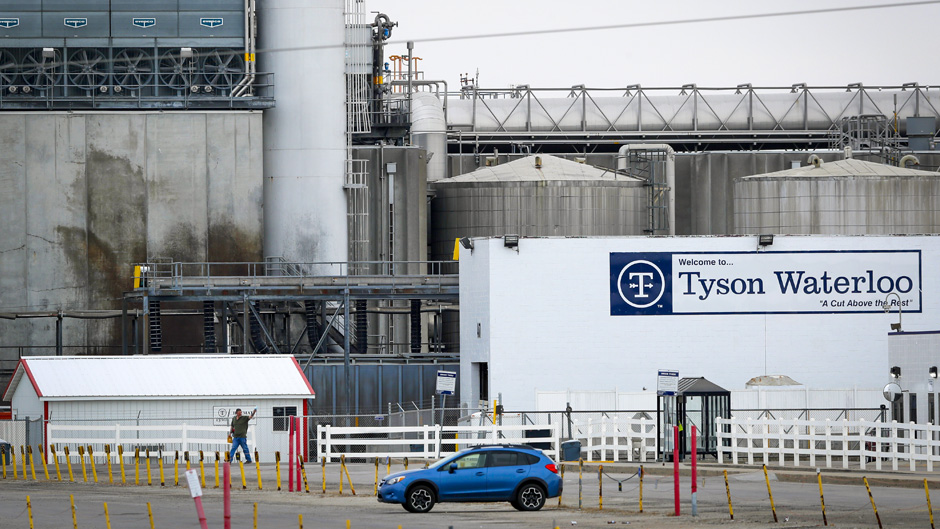As the pandemic continues its infectious spread, few might have imagined that towns in Iowa and South Dakota would become among the deadliest hotspots for the virus. But the Midwest and Great Plains are home to large meatpacking plants for Tyson and Smithfield that produce much of the poultry, beef, and pork sold in U.S. supermarkets.
These facilities, where thousands of people work 8- to 10-hour shifts standing shoulder to shoulder earning an hourly wage, have become, according to Successful Farming magazine, the “coronavirus leaders.”
The Smithfield plant in Sioux City, South Dakota, has one of the largest known clusters of COVID-19 cases in the country. Cases in the state have quadrupled since late April and the death rate continues to climb, according to scientists with the federal Centers for Disease Control and Prevention and reported in Successful Farming.
In late April and amid reports of declining U.S. meat supply, President Donald Trump authorized the agricultural secretary, based on a statute of the Defense Production Act, to do what he must to reopen plants that had closed and to keep others open. The legal power of the president’s order remains uncertain, yet many interpreted the statement as an executive order. No actions have yet been taken.
Andrew Elmore, a professor in the University of Miami School of Law with expertise in labor and employment law, pointed out that the federal government, via the Occupational Safety and Health Act (OSHA), has primary responsibility for regulating safety and health in the workplace.
Employees have the right to refuse to work in dangerous conditions, and OSHA requires employers to “furnish … a place of employment … free from recognized hazards that are causing or are likely to cause death or serious physical harm to his employees,” Elmore cited.
“Historically OSHA provides for specific standards, but OSHA has failed to enact emergency standards to require employers to reopen safely,” Elmore said. “The guidelines are voluntary, and OSHA is not enforcing them—there is no private right of action to enforce OSHA, so the statute relies entirely on public enforcement.”
Elmore recognized that OSHA suffers from lack of resources. “And it’s gotten worse,” he said, noting that at its height in 1980 the agency had 1,469 inspectors. According to Elmore, as of the beginning of this year, OSHA counted on 862 inspectors to protect the safety and health of 150 million workers.
Rebecca Sharpless, professor and director of the School of Law’s Immigration Clinic, noted that the hard, low-paying plant jobs, like field and farm work, tend to attract many immigrant workers. Upwards of 30 percent of workers in the processing plants are foreign-born.
“It’s questionable that these plants are continuing to operate in the face of COVID,” Sharpless said. “The workers are at the mercy of those who control the factories, and they don’t have enough political power.”
Sharpless likened the risks for plant workers to the conditions in jails, where, because of close conditions and the absence of protections, detainees are especially vulnerable.
“When you see a vulnerable population that doesn’t have power, you see very questionable practices. The jail is one of those settings, and these factories where low-wage workers work is another,” she said. “It points to the class aspect of enduring this COVID experience, that low-income workers and people who are vulnerable are having a very different experience from that of people who are able to safely quarantine at home and telecommute—we need to keep that in mind.”
Elmore pointed out that some states have helped “fill the gap” where the federal government fails to safeguard workers, and that workers are attempting to take collective action to protect themselves.
“Federal labor law (the National Labor Relations Act or NLRA) protects the right of even non-union employees to engage in collective actions to protect their safety and health,” he said. “We are seeing an unprecedented increase in worker participation in strikes to protest unsafe workplaces.”
While some insist that the meat food supply chain is essential and must be maintained, others argue that workers’ safety and health take precedence. Is there a way to resolve this tension?
“I’m not sure there is a tension,” Elmore said. “When employees must work in unsafe circumstances, it is a public health hazard.”
He referenced the situation at the Smithfield plant in South Dakota. “Many retail establishments have reported that their employees have gotten sick, and this means that customers are at risk too. Preventing a second wave will require safely reopening business establishments. This seems to me to be an area where labor and health officials are, or should be, working in lock step.”
Companies have instituted some additional safeguards such as face shields and additional testing at the plant sites. In a notice on its website, Smithfield stated: “Our more than 40,000 U.S. team members, thousands of American family farmers, and our many supply chain partners are a crucial part of our nation’s response to COVID-19.”
While plant workers call for more protection equipment and labor advocates urge slowing down production lines to require fewer workers and allow greater distance between workers, Elmore said there are no historic precedents that might offer alternatives to the current dilemma.
“Economists have estimated that the United States is facing its highest unemployment rate since the Great Depression, and this is also the biggest workplace safety and health crisis we’ve faced in our lifetimes,” Elmore said. “And OSHA is less prepared for it than it has been in my memory.”

